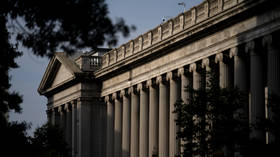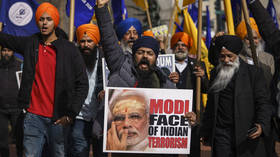US is at a critical juncture, facing TWO EPIDEMICS: Covid-19 & soaring joblessness

The Senate and the White House have finally managed to negotiate a record $2-trillion stimulus aid package to ease the economic impact of the coronavirus outbreak. But the money may well be too little too late.
Once approved, the bill will go to the House of Representatives for likely approval there after which it will go to the president’s desk for signing.
American and global stock market reaction has so far been lackluster.
The problem is that the once virtuous circle of increasing jobs, increasing spending and corporate profits, and more hiring that keeps the economy rolling is breaking due to recession caused by coronavirus. Unless the US can slow the growth of the coronavirus epidemic and deal decisively with soaring unemployment, which threatens to reach levels not seen since the Great Depression of the 1930s by summer, both crises could become a death spiral.
The problems facing the US are long-standing and deep. Alone among most developed nations, the US has what Norway’s University of Science and Technology, in a letter to students studying abroad, delicately termed as “poorly developed health services and infrastructure.” The US also, after decades of harsh cut-backs, at this point has only the last few remaining threads of what was even at best called a ‘social safety net’ to provide for those without jobs, or with jobs that paid too little to meet basic needs like rent and food.
Faced with the coronavirus pandemic, which has now infected over 55,000 people in all 50 states, and with a shocking shortage of Covid-19 test kits because of poor planning by the government, the best that the US can do is lock down the economy. State after state has done this, ordering schools, colleges and all but essential businesses to shut down, with everyone in non-essential jobs ordered to hole up in their homes for the indefinite future. Many major US cities today resemble ghost towns, with patrolling police and ambulances providing the only signs of life.
Joblessness is becoming a kind of second epidemic, growing and spreading even more rapidly than Covid-19. So many people are suddenly being laid off that President Trump even tried to persuade state governments, which are responsible for administering unemployment compensation programs, not to report the actual number of new unemployment comp applications for March. He failed in that endeavor, with Fortune magazine projecting that 5-6 million workers could end up losing their jobs in March alone by the end of this month – a situation the magazine calls “cataclysmic.” According to a new report by the Economic Policy Institute, 3.4 million of these laid off workers reportedly applied for benefits over the past week. That number is 50 percent higher than the total number of new applications for unemployment benefits filed over the prior 12 months, and is the greatest number for a single month filed in the nation’s history. Far more laid off workers are expected to claim benefits in April, and even more in May.
Nor is the number of new unemployment compensation applications a particularly good measure for how many people have actually lost their jobs. In the US, only about 27 percent of workers are even eligible for the meager benefit checks the system pays out, but the percentage varies by state, with 57 percent of workers in Massachusetts covered, and only 10 percent of workers in North Carolina, the state with the fewest of its workers eligible for benefits.
Many smaller businesses are exempt from the requirement to pay into the unemployment insurance system. And 20 percent of workers in the US these days – from construction workers and oilfield workers to magazine writers, insurance brokers, to some nurses, elderly caregivers, cab drivers and landscape workers – are considered ‘independent contractors’, or in effect, independent businesspeople, entitled to nothing when the company hiring them lets them go, whatever state they’re working in.
Also on rt.com Covid-19 has exposed just how broken American economy & society are – a $2 trillion package alone won’t fix itLast week, Treasury Secretary Steven Mnuchin warned Congress that the US could have 20 percent unemployment before summer if the coronavirus crisis continues and if legislators don’t pass record stimulus and worker support legislation. Aware that most of these people and their families – perhaps 100 million in all, or a quarter to a third of the entire US population – will suddenly be without any income or support, Congress is debating giving some kind of cash grant to virtually every American citizen, but it would only amount to $1000-$1500 per adult, which is not enough to cover rent and food for a month.
And that’s where the cliff comes in.
The US has the world’s second largest economy and its manufacturing output may seem large, but the US Bureau of Economic Research reports that manufacturing only accounts for 11.6 percent of Gross Domestic Product – slightly more than half of the share health care accounts for. Meanwhile, consumer spending accounts for nearly 80 percent of total Gross Domestic Product. That begs the question: How does a country that doesn’t actually produce much anymore besides movies and weapons still have a functioning economy, or even a functioning society, if nobody has any money to spend any longer?
If people don’t have money, they don’t buy anything but the bare necessities. But if nobody is buying, the companies selling everything from toys and food to guns, cars, and theater tickets go under. Even mighty Amazon, which is currently raking in money as the only place people can turn to get anything since it delivers to the door, may soon find its customers vanishing for everything but toilet paper, and sanitizer and masks.
Look at the airline industry. With nobody flying, they’re sitting there with all these huge leases on aircraft and no ticket revenue to pay the monthly bill. The Congressional rescue package will offer them access to up to $50 billion in loans, but if people still aren’t flying, that money won’t go very far and the airlines will end up saddled with debt they can’t hope to repay.
The Big Three automakers, GM, Ford and Fiat Chrysler, can’t have workers coming in and getting each other sick with coronavirus, and besides, nobody’s in the mood to buy a car now, so they’ve all closed down. But these auto-makers have a combined debt of $262 billion (GM: $94.2 billion, Ford: $155 billion, Fiat-Chrysler: $12.9 billion) on which they have to pay interest whether they’re making and selling cars or not. How long can these big companies go without selling cars and trucks? In the last recession in 2008-09, remember, GM had to be bailed out of bankruptcy with $49.5 billion in government cash and loans or the iconic company would have disappeared.
Across the whole US economy, this existential crisis is playing out in business after business.
In good times, companies doing business earn revenues that allow them to pay wages to employees, who then go out and buy goods and services in a virtuous circle that keeps the economy chugging along or hopefully growing. But when that circle breaks down, as it is now doing in the US with a vengeance, the virtuous circle can quickly become a death spiral: Less income for workers means less buying power and depressed demand for goods – especially non-essential goods. People with a negative view of the future aren’t going to buy a new house or car or spend on luxuries like designer clothes or theater tickets, so businesses lay workers off, and the economy goes further south.
And that’s the risk facing the US now. Dean Baker, senior economist at the Center for Economic and Policy Research in Washington and visiting professor of economics at the University of Utah, told this author that everything depends now upon both widespread testing for coronavirus becoming available quickly, and Congress passing a bill that puts significant money into the hands of all American workers and the unemployed so that there isn’t massive hunger, evictions, and homelessness.
“If that happens and if this pandemic crisis is over within the next two to three months, you could see a pretty good recovery,” Baker says. “After all, if Congress passes some kind of program to get money to people, many will be saving money, and you’ll have a lot of spending once things start to open up again. But if the crisis goes on more than three months, I think it will be hard to hold things together.”
The current rescue package working its way to passage by Congress, which just provides each American with $1200, and just half of that amount for those who were already under the poverty line before the crisis began, is half what many economists, including Baker, say would be needed even for a short-term economic jump-start.
Other economists are offering direr views than Baker. Roger Framer, an economics professor at the University of Warwick in the UK, says, “The longer this disruption goes on, the more likely it will have a permanent effect… Three weeks we can bounce back from. Three months, it’s not so clear.”
Also on rt.com The working class should be hailed as Covid-19 heroes for enabling all our comfy quarantinesDion Rabouin, markets editor with Axios, says, “The Coronavirus could force the world into an unprecedented depression.” He adds, “In the latest repricing of the economy, the [stock] market sees the now expected global recession caused by the coronavirus outbreak morphing into an economic depression unlike any the world has seen in generations.”
Meanwhile across the US, millions of people, their jobs gone, are locked down in their homes, their cupboards and closets stuffed with canned goods, toilet paper, and sanitizer bottles, their refrigerators packed with fresh food and frozen food, and are watching TV news reports of the unrelenting rapid spread and expansion of the coronavirus – and are wondering where it will all end.
Hearing the reports from across the nation of desperate shortages of masks, ventilators, hospital beds, and especially test kits to discover who’s infected and who’s not, they understand it won’t end soon, and until it does, things won’t be pretty.
Think your friends would be interested? Share this story!
The statements, views and opinions expressed in this column are solely those of the author and do not necessarily represent those of RT.















